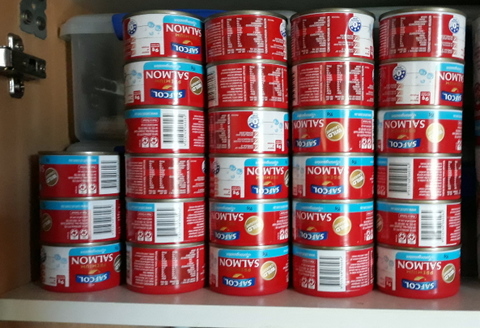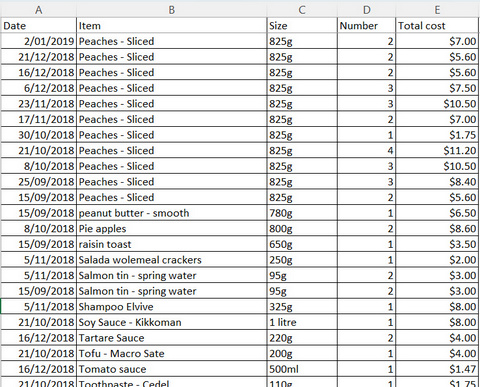
A buying audit is complementary to a ‘Pantry Audit’ in that the pantry audit tells you in some detail of the food which you have on hand at the time of the audit, the ‘Buying Audit’ allows you to track the type, amount and cost of foods coming into the household over time.
I have a fair idea of the sorts and amounts of food which we buy in general, but there is no substitute for measuring and for recording the data. We have a supermarket, greengrocer and butcher within walking distance and to save transport energy these tend to be our go-to.
I wanted to know what we were spending so I could see what opportunities there were for –
• Home production
• Bulk buying
• Substituting from other sources.
First, I set the criteria for the audit. It would cover food purchases from the supermarket and greengrocer and to a lesser extent, butcher which we have been using less and less as we move towards a plant-based diet. It did not include: takeaway (traditional on a Friday night) or bulk purchases like a 25kg of rolled oats and skim milk powder ($90 and $120 respectively) which occurred during the time of the audit.
To help me record the data I was generating I put together a (very) simple Excel spreadsheet. Excel spreadsheets also have a ‘sort’ function which helps me to analyse the data by grouping together purchases of similar products over time. The headings I used for the grocery sheet was –
Date – so that I had an idea of the time that items I purchased regularly would last before they needed to be rebought.
Item – this one is important to get right and by that I mean to use the same item name each time they are entered on the spreadsheet. If an item is entered as ‘baked beans’ initially then ‘beans, baked’ when bought next and then as ‘Fred’s Baked Beans’ a third time it makes sorting for analysis very difficult. Entering each item under the same name each time means they will group together when sorted. Simple I know but it easy to make a mistake……. Or so I’ve heard!
Size – how many grams, kilos or litres of each product is bought at a time, which can give you a feeling for how much of each product is bought over the time of the audit, and can then be extrapolated over a month, 6 months, or year or whatever. Thus you can hit the high use stuff first.
Number – This is just there so that when I bought multiples of the same item, I didn’t have to enter each one separately, but I would still be able to work out the total numbers of that item over the period being measured.
Total cost – how much each item (or number of items) cost all up to give me an idea of how much I was spending over time. This column could be aggregated to give me a total spend during the audit timeframe.
I then put together as similar sheet for Fruit and Veg, and meat. If you want a blank copy to model your own on, it can be downloaded here (Grocery Data Blank).

Sample of what the records may look like
To operate the audit was a fairly simple matter. Every time I made a purchase within the criteria I had set out I made sure to get the receipt and then as soon as I got home (mostly, alright I saved them up until the end of the week!) entered the data for each one into the spreadsheet. I did this for a period of four months, but you could do it for as long or short as you like, bearing in mind that the longer it goes on for, the more information it will yield.
After four months I sat down and did a bit of analysis, the easiest way to do that (for me) was to sort for item name so that the items were aggregated, and it turns out over those 4 months we bought –
• 9 tins of sliced beetroot, total weight 7.5kg for a bit over $21 (could be home produced and/or preserved)
• 26 tins of sliced peaches (in juice), total weight 21.5kg for $80.65 (no way to grow at our place but could be bought in bulk in season and home preserved)
• 16 x 750g loaves of bread for $76 (home baking)
• All up $746 worth of groceries, $260 worth of F&V and $10 worth of preserved meats for homemade pizza (we did have some meat in the freezer we were working through to use up).
• Not too bad for a family of 2 for four months, I think!
This approach can also be used to identify other consumables such as cleaners, paper products, personal care products or what have you! It all depends on how much information you want to generate about your spending habits.
It depends on what is important to you and what your big-ticket items are in your journey towards living a sustainable life, but whatever they are decide what you need to measure to control them, and then do it!



